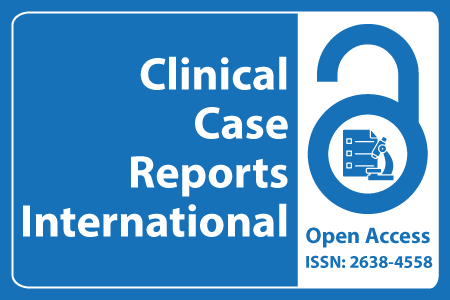
Journal Basic Info
- Impact Factor: 0.285**
- H-Index: 6
- ISSN: 2638-4558
- DOI: 10.25107/2638-4558
Major Scope
- Neurology
- Food Science
- Family Medicine and Public Health
- Anesthesiology and Pain Medicine
- Emergency Medicine and Critical Care
- Depression
- Hepatology
- Child Birth
Abstract
Citation: Clin Case Rep Int. 2024;8(1):1671.DOI: 10.25107/2638-4558.1671
Application of Thyroid Cartilage Recording Electrode for Intraoperative Neuromonitoring During Giant Retrosternal Goiter Surgery
Zhang M, Shao G, Sun B, Shi M, Wang X, Song Y, Zhang G and Li G
The First Clinical Medical College, Shandong University of Traditional Chinese Medicine, China
Department of Thyroid and Breast Diagnosis and Treatment Center, Weifang Hospital of Traditional Chinese Medicine, Shandong Second Medical University, China
Department of Ophthalmology, Affiliated Hospital of Shandong Second Medical University, China
These authors have contributed equally to this work and share first authorship
*Correspondance to: Guangdong Shao
PDF Full Text Case Report | Open Access
Abstract:
Background: At present, the vocal cord surface contact electrode attached to the endotracheal tube is the mainstream device at the receiving end of the intraoperative neuromonitoring system. However, the application is often limited in patients with difficult airway caused by the oppression of a huge goiter. Methods: A 66-year-old man from China came to our department because of the compression, displacement and deformation of trachea caused by huge retrosternal goiter. Our preoperative evaluation found that it was difficult to insert a traditional endotracheal tube with surface electrodes in his condition. Thus, we selected the thyroid cartilage recording electrodes to monitor the neural signals and reduce the probability of recurrent laryngeal nerve injury during the surgery. Results: The lesion in this patient was completely excised, along with complete protection of the recurrent laryngeal nerve and vagus nerve. There were no complications, such as hoarseness, coughing upon drinking water, and dyspnea after the operation, the patient recovered well. Conclusion: The intraoperative neuromonitoring system technique using thyroid cartilage recording electrodes was an effective method for reducing recurrent laryngeal nerve injury during giant retrosternal goiter surgery.
Keywords:
Giant retrosternal goiter; Intraoperative neuromonitoring; Thyroid cartilage recording electrode; Recurrent laryngeal nerve injury
Cite the Article:
Zhang M, Shao G, Sun B, Shi M, Wang X, Song Y, et al. Application of Thyroid Cartilage Recording Electrode for Intraoperative Neuromonitoring During Giant Retrosternal Goiter Surgery. Clin Case Rep Int. 2024; 8: 1671.













